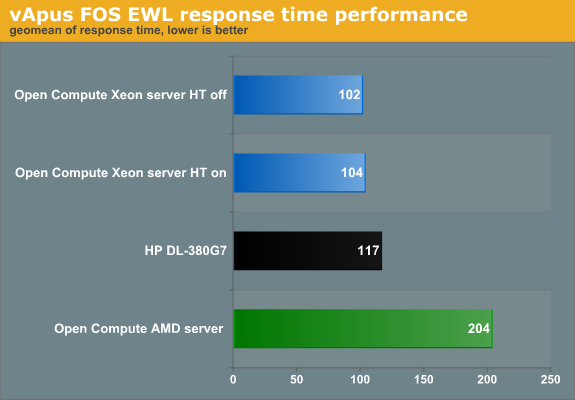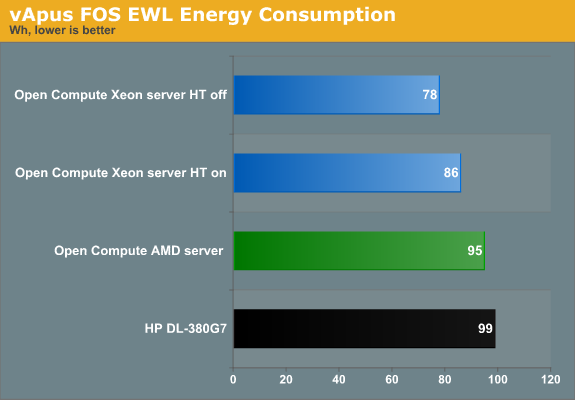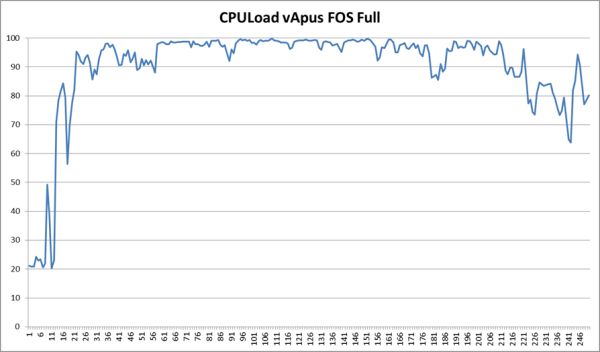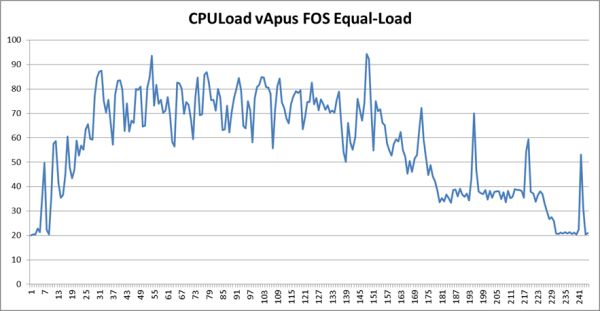Facebook's "Open Compute" Server tested
by Johan De Gelas on November 3, 2011 12:00 AM ESTMeasuring Real-world Power Consumption, Part 1
vApus FOS EWL
The Equal Workload (EWL) test is very similar to our previous vApus Mark II "Real-world Power" test. To create a real-world “equal workload” scenario, we throttle the number of users in each VM to a point where you typically get somewhere between 20% and 80% CPU load on a modern dual CPU server. This is the CPU load of vApus FOS:
Note that we do not measure performance in the "start up" phase and at the end of test.
Compare this with vApus FOS EWL:
In this case we measure until the very end. The amount of work to be done is always equal, and the faster the system, the sooner it can idle. The time of the test is always the same, and all tested systems will spend some time in idle. The faster the system, the faster the workload will be done and the more time will be spent at idle. For this test we do not measure power but energy (power x time) consumed.
The measured performance cannot be compared as in "system x is z% faster than system y", but it does give you an idea of how well the server handles the load and how quickly it will save energy by entering a low power state.

The Xeons are all in the same ballpark. The AMD system with its slower CPUs needs more time to deal with this workload. One interesting thing to note is that Hyper-Threading does not boost throughput. That is not very surprising, considering that the total CPU load is between 20 and 80%. What about response time?

Note that we do not simply take a geomean of the response times. All response times are compared to the reference values. Those percentages (Response time/reference Response time) are then geometrically averaged.
The reference values are measured on the HP DL380 G7 running a native CentOS 5.6 client. We run four tiles of seven vCPUs on top of each server. So the value 117 means that the VMs are on average 17% slower than on the native machine. The 17% higher response times are a result of the fact that when a VM demands two virtual Xeon CPUs, the hypervisor cannot always oblige. It has 24 logical CPUs available, and 28 (7 vCPUs x 4 tiles) are requested. In contrast, the software running on the native machine gets two real cores.
Back to our results. The response time of the AMD based server tells us that even under medium load, a faster CPU can help to reduce the response time, which is the most important performance parameter anyway. However, Hyper-Threading does not help under these circumstances.
Also note that the Open Compute server handles this kind of load slightly better than the HP. So while the Open Compute servers offer a slightly lower top performance, they are at their best in the most realistic benchmark scenarios: between 20% and 80% CPU load. Of course, performance per watt remains the most important metric:

When the CPU load is between 20 and 80%, which is realistic, the HP uses 15% more power. We can reduce the energy consumed by another 10% if we disable Hyper-Threading, which as noted does not improve performance in this scenario anyway.












67 Comments
View All Comments
fpsvash - Thursday, November 3, 2011 - link
In the middle of the paragraph below the image caption, the sentence reads "...and offers better slightly better performance..."Other than that, nice post!
ahmetmy330 - Thursday, December 29, 2016 - link
this is my university work about open servers. Thanks for posthttp://www.h2kjamaica.com/maddenmobilehack/
InternetGeek - Thursday, November 3, 2011 - link
It's interesting that no many players have taken a look at Open Compute.alent1234 - Thursday, November 3, 2011 - link
it's a solution for a specific workload. there are still a lot of workloads that require the traditional model of big database serversunlike your bank, facebook's noSQL is not ACID
FunBunny2 - Saturday, November 5, 2011 - link
Well, yes a voice of reason. OTOH, the Facebook et al folks are convinced that their back to the COBOL era is the future. As if a toy application, albeit pervasive, is "innovation".Sivar - Saturday, November 5, 2011 - link
It's a little difficult to look at a comment about Facebook being a toy application and take it seriously. Yes, Facebook is not directly processing bank transactions on a Tandem, but their site is used to conduct business -- and is even the basis for many businesses, all over the world.Zynga, the company that makes a few annoying games for Facebook, is worth $15 -- more than Electronic Arts.
Nearly every major online publisher, including Anandtech, uses their API for content distribution and often as the entire forum system for discussion of publications.
The founder is the youngest billionaire in history.
Calling theirs a toy application sounds like a Blockbuster customer calling Redbox a toy. It's denial of an obviously successful, large, powerful, innovative company because they don't do things "the old way."
I suspect what matters more is that the business is executing flawlessly, the actual problems with data loss or other non-ACID compliant traditional issues are minimal, and that they are making enough money that Google and Microsoft are feel seriously threatened.
One last thing -- if you really look into what ACID compliance means (and I know you did not specifically mention the acronymn, but replied to someone that did) none of the current major DBMS's are truly ACID compliant. It's too slow. Not Oracle. Not MSSQL. Not Greenplum. Not Teradata. None of them. They may be closer than NoSQL or the like, but then it's all about the right tool for the job, right?
Ceencee - Wednesday, November 9, 2011 - link
This is true but ACID can be over-rated for many workloads. How many pieces of data HAVE to be consistent across the entire cluster to be valid? What about NoSQL with configurable consistency like Cassandra?NoSQL databases provide the holy grail of system growth which is horizontal scaling and this is no small thing for anyone who has worked with a very large RDBMS like ORACLE and implemented RAC to find it doesn't scale all that linearly for most workloads.
ahmetmy330 - Sunday, January 1, 2017 - link
ctually i assume you might have actually stumble upon these dubious <a href="http://www.h2kjamaica.com/bowlingkinghack/"&g... King cheats </a>programs and software packages downloads but are convinced usahmetmy330 - Thursday, January 12, 2017 - link
http://www.onslow.us/8ballpoolhack/I have told you
ac2 - Thursday, November 3, 2011 - link
Wouldn't the presence of the graphics on the HP server account for the 32W idle load savings?